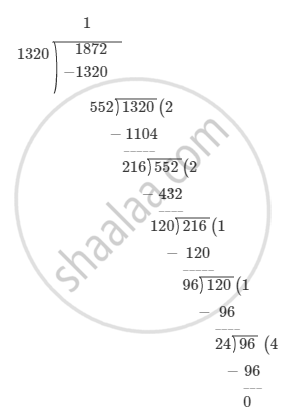Advertisements
Advertisements
Question
A rectangular courtyard is 18 m 72 cm long and 13 m 20 cm broad. It is to be paved with square tiles of the same size. Find the least possible number of such tiles.
Solution
Length of the courtyard = 18 m 72 cm = 1872 cm
Breadth of the courtyard = 13 m 20 cm = 1320 cm
Now, the maximum edge of the square tile is given by the HCF of 1872 cm and 1320 cm.
HCF of 1872 and 1320 = 24
∴ maximum edge of the square tile = 24 cm
APPEARS IN
RELATED QUESTIONS
Fill in the blanks:
On dividing 9 by 7, quotient = ____ and remainder = ____.
Fill in the blank:
Every number is a factor of ______
Fill in the blank:
Every number is a multiple of ______
Fill in the blank:
______ is factor of every number.
Reduce each of the following fraction to the lowest term:
`517/799`
Determine the longest tape which can be used to measure exactly the lengths 7 m, 3 m 85 cm, and 12 m 95 cm.
The HCF of two numbers is 145 and their LCM is 2175. If one of the numbers is 725, find the other.
Find the least number which when divided by 25, 40, and 60 leaves 9 as the remainder in each case.
In the grid here, a rectangle made of 20 boxes is drawn.
The width of this rectangle is 2 boxes.
- What is its length?
There are 18 bangles on the rod. Meena is trying to group them. She can put them in groups of 2, 3, 6, 9, and 18 — without any bangle being left.
- How many groups will she have if she makes groups of 1 bangle each?
